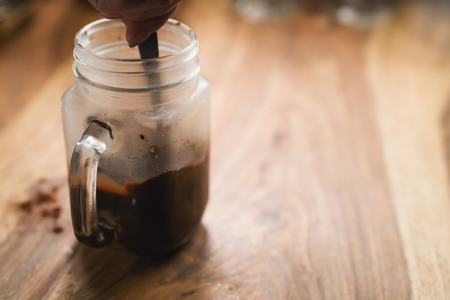Understanding Cold Brew Concentrates
If youve wandered through London’s independent coffee shops or scrolled through a UK-based barista forum lately, you’ll have noticed a growing fascination with cold brew concentrates. But what exactly are these potent brews, and how do they stand apart from the usual cold brew you might sip on a lazy Saturday in Soho? In essence, cold brew concentrate is a highly concentrated form of coffee, brewed slowly with cold water and a hefty dose of freshly ground beans. Unlike standard cold brew—which is typically diluted and ready to drink—concentrates offer an intense, bold profile that’s designed to be mixed, customised, or even sipped straight for those feeling particularly brave on a drizzly British morning.
The beauty of cold brew concentrates lies in their adaptability. Home baristas across the UK are smitten with the idea that one batch can serve as the foundation for a week’s worth of iced lattes, affogatos, or even cheeky coffee cocktails. This versatility means you’re never far from a proper cup, whether you’re dashing off to the office or enjoying a slow moment on your balcony. The concentrate’s punchy flavour captures the nuanced notes of your favourite single-origin beans—think nutty undertones from Bristol roasters or chocolatey richness from Edinburghs finest—making it an ideal playground for those keen to explore coffee beyond the ordinary mug.
So why all the fuss? Beyond convenience and taste, cold brew concentrates allow home baristas to flex their creative muscles while keeping things refreshingly simple. It’s about having that bottle in your fridge—a little secret stash of caffeinated possibility—ready to transform any moment into something special, British weather be damned.
Essential Equipment and Ingredients
For the home barista in Britain, embarking on the journey of cold brew concentrates is a satisfying blend of practicality and quiet ritual. To truly capture that chilled, velvety elixir—one that feels right at home whether you’re in a London flat or a Cotswolds cottage—you’ll need some thoughtfully chosen equipment and ingredients. Here’s what you’ll want to have on hand:
Must-Have Gear for Every Home Brewer
| Equipment | Why It Matters | British Alternatives/Notes |
|---|---|---|
| Cafetière (French Press) | Classic, accessible, perfect for steeping grounds. | A staple in many British kitchens; sturdy and familiar. |
| Mason Jars or Large Pitchers | Ideal for batch brewing and storing concentrate. | Repurposed jam jars work a treat—very “make do and mend.” |
| Fine Mesh Sieve or Muslin Cloth | For straining out coffee grounds to get that smooth finish. | Muslin cloths are easy to source from local markets. |
| Kilner Bottles (or any sealable bottle) | Keeps your concentrate fresh in the fridge. | Kilner is a beloved British brand—iconic and practical. |
| Digital Scales & Measuring Jug | Precision matters for consistency in flavour. | No need to be too fussy—kitchen scales will do nicely. |
Sourcing Quality Beans: The Heart of Your Brew
The soul of any cold brew concentrate lies in its beans. While supermarket blends may suffice in a pinch, if you’re after true British character, consider supporting your local roastery. Look for beans roasted within the UK, as freshness makes all the difference. Many independent shops—from Bristol to Edinburgh—carry single origin options that lend themselves beautifully to cold extraction. For something distinctly British, try beans with chocolatey, nutty notes (think: Colombian or Brazilian) that pair well with milk or oat alternatives so popular in our high streets.
Tips for Choosing Beans:
- Roast Level: Medium or medium-dark roasts tend to yield a balanced flavour profile, avoiding both excessive bitterness and tartness when brewed cold.
- Grind Size: Ask your local shop for a coarse grind—about the texture of coarse sea salt—to prevent over-extraction and cloudiness.
- Sustainability: Opt for Rainforest Alliance or Fairtrade certified beans if possible; it’s an easy way to support ethical sourcing while you sip.
A Final Word on Water
Never underestimate the power of good water—it’s the unsung hero of every great cup. If you’re in a hard-water area (hello, London), consider filtered water to let those nuanced coffee notes shine through. With your kit assembled and ingredients sourced with care, you’re set up for cold brew success—one glass at a time, wherever your city rhythm takes you.

3. Brewing Methods and Pro Tips
If you’re longing to craft cold brew concentrate that can stand up to the chicest East London café or a proper Bristol brunch spot, you’ll want to start with a method that’s both practical and precise. Here’s your step-by-step guide, blending British practicality with a dash of artisanal flair.
Step 1: Choose Your Batch Size
The beauty of cold brew concentrates is their flexibility. Whether you’re brewing for yourself or enough to share at a Sunday gathering, it’s all about ratios. A classic British measure might be 200g of coarsely ground coffee to 1 litre of cold, filtered water. For smaller flats or solo sipping, halve the quantities—no need for excess, just enough for quality.
Step 2: Mind Your Steeping Time
This isn’t a mad dash; think more along the lines of a slow stroll through Hyde Park. Once you’ve combined your grounds and water in a large jar or French press, give it a gentle stir—no need for overzealous agitation. Pop it in the fridge (or a cool pantry corner) and let it steep for 12 to 18 hours. Less time brings out lighter, tea-like notes; longer gives you that rich, chocolatey depth beloved in Manchester’s indie cafés.
Pro Tip: Taste as You Go
After 12 hours, have a cheeky taste. If it sings with subtle fruitiness but lacks body, leave it for another few hours. Like choosing the right vinyl for a rainy afternoon, it’s all about personal preference.
Step 3: Strain for Clarity
Once steeped, strain through a fine mesh sieve lined with muslin cloth or even an old-school paper filter. This keeps your concentrate smooth—think less gritty bus-stop coffee, more gallery-opening chic.
Pro Tip: Double Strain for Nuance
If you’re after that perfectly clean finish found in Soho’s artisan spots, double strain your concentrate. It makes all the difference when blending into iced drinks or cocktails later on.
Final Touches: Achieving That Nuanced Flavour Profile
The best home baristas know that temperature and grind size are secret weapons. Use cold water—not tepid tap—and opt for a coarse grind reminiscent of breadcrumbs rather than powdery dust. This helps avoid bitterness and highlights those delicate notes of caramel, berry, or floral undertones lurking in your beans.
With these brewing methods and pro tips under your belt, your kitchen becomes less commuter chaos and more Covent Garden calm—a haven where each batch of cold brew concentrate is uniquely yours, ready to anchor any morning ritual or evening wind-down.
4. Creative Ways to Use Cold Brew Concentrates
If you think cold brew concentrate is just for a straightforward iced coffee, it’s time to broaden your caffeinated horizons. Whether you’re embracing the brisk mornings in London or unwinding in the gentle embrace of the Cotswolds, cold brew concentrate is a versatile companion in your culinary toolkit. Let’s explore some inventive ways to bring a dash of creativity—and perhaps a hint of rebellion—into your daily routine.
Elevate Your Everyday Drinks
Why not swap out your usual morning cuppa for something with a bit more flair? With cold brew concentrate, there’s no need to limit yourself to traditional lattes. Here are a few British-inspired twists:
| Drink | Description |
|---|---|
| Iced Flat White | A shot of cold brew concentrate topped with chilled milk and ice, reminiscent of your favourite high street café. |
| Cold Brew Tonic | Pour cold brew over tonic water and garnish with a slice of orange—refreshing, slightly bitter, and perfect for a summer afternoon in Hyde Park. |
| Spiced Cold Brew Latte | Add a pinch of cinnamon or nutmeg before topping up with oat milk for that autumnal touch, no matter the season. |
Cocktails with a Coffee Kick
For those evenings when you fancy something a little stronger, cold brew concentrate slides easily into your cocktail repertoire. Picture this: sipping an Espresso Martini at a Soho speakeasy, but crafted in the comfort of your own kitchen.
Favourites to Try:
- Cold Brew Negroni: Replace gin with cold brew concentrate for a sophisticated twist on the Italian classic.
- Boozy Affogato: Pour cold brew over vanilla gelato and spike it with a splash of whisky—a decadent dessert to end any dinner party.
Baking and Beyond
The depth and smoothness of cold brew can work wonders in baking, giving cakes and biscuits an edge that’s both subtle and alluring. Imagine rich coffee-infused brownies gracing your table during teatime, or a drizzle of cold brew syrup over warm scones on a rainy Sunday afternoon.
Baking Ideas:
- Add cold brew concentrate to cake batters or buttercream for layered flavour.
- Mix into homemade ice cream bases for an elegant grown-up treat.
- Create coffee glazes for doughnuts or pastries—the possibilities are boundless.
So whether you’re after a twist on your morning pick-me-up or looking to impress at your next gathering, let cold brew concentrate be your muse as you weave city energy or countryside calm into every sip and bite.
5. Storing and Maintaining Freshness
For the aspiring home barista, preserving the vibrancy and nuanced notes of your cold brew concentrate is a subtle art—almost as quintessentially British as a well-organised pantry. Once you’ve steeped your beans to perfection, storage becomes paramount. First things first: always decant your cold brew concentrate into a glass container with an airtight seal. Plastic containers can impart unwanted flavours, and even stainless steel can sometimes meddle with the delicate profile you’ve worked so hard to craft.
Keep your concentrate in the fridge—ideally at the back, where the temperature remains most consistent, rather than the door which gets a good bashing every time someone fancies a snack. A classic British hack is to reuse sterilised glass milk bottles or even an old gin bottle (thoroughly washed, of course) for both style and practicality—a touch of upcycling that adds charm to your kitchen counter.
When it comes to longevity, your cold brew concentrate should stay fresh for up to two weeks if properly stored. However, for optimum flavour, aim to use it within seven days. Some aficionados swear by slipping in a slice of lemon peel or a few whole coffee beans; this doesn’t just look charmingly artisanal but also helps ward off staleness in true British thrift fashion.
Avoid repeated exposure to air by pouring only what you need each time—think of it like guarding the last biscuit in the tin from greedy hands. And if you’re keen on batch brewing for convenience, consider portioning out your concentrate into smaller containers. This way, each bottle stays sealed until needed, preserving both taste and aroma until that next caffeine craving strikes.
Lastly, don’t forget: give your cold brew a gentle swirl before serving, especially if you notice any settling at the bottom—no need for vigorous shaking. It’s all about keeping things calm and collected, much like a foggy morning stroll along the Thames. With these tips, your homemade cold brew will retain its café-level freshness and remain ready to pour over ice—or perhaps even into an afternoon affogato—at a moment’s notice.
6. Troubleshooting Common Mistakes
Every home barista’s journey with cold brew concentrates comes with the occasional hiccup, but don’t fret—these little blips are just part and parcel of crafting your own urban elixir. Let’s have a friendly natter about those familiar pitfalls and how you might elegantly sidestep them, as if we were chatting over coffee in a cosy Soho nook.
Over-Extraction: When Your Brew Bites Back
If your concentrate tastes more like the Thames at low tide than a smooth city pick-me-up, you’ve likely over-extracted. This usually happens when coffee grounds and water mingle for too long or your grind is too fine. The fix? Try using a coarser grind—think sea salt rather than powder—and trim your steeping time to 12–16 hours. If it’s already brewed, dilute with filtered water or milk until the bitterness mellows out, just like easing into a London drizzle under an umbrella.
Weak Brews: When It’s All Style, No Substance
If your cold brew feels more like coloured water than a caffeine kick, chances are you’ve gone too light on the coffee or cut the steep short. Don’t be shy—up your coffee-to-water ratio next time (a good starting point is 1:4 by weight). And if you’re caught out midweek with a limp batch, simply pop it back in the fridge with some fresh grounds for another few hours—a cheeky second steep can work wonders.
The Grind Matters More Than You Think
Grind size is your silent partner here; too fine and you risk silt and bitterness, too coarse and extraction falls flat. Invest in a burr grinder if you can—it’s the difference between a proper pint and one that’s all froth, no flavour.
Cloudy Concentrates: The Murky Middle Ground
If your cold brew looks cloudy, blame it on over-agitation or insufficient filtering. Pour through a paper filter or a clean muslin cloth for clarity worthy of an East End morning after rain.
Take Notes Like a True Londoner
Finally, keep a brew diary—a bit of old-school charm never hurt anyone. Note down ratios, times, and even the weather outside. After all, every good barista knows their best brews are born from a pinch of curiosity and a dash of trial and error.
Remember, even in the most bustling corners of London, nobody gets it perfect every time. Embrace these learning moments—they’re what give your cold brew its unique city soul.

